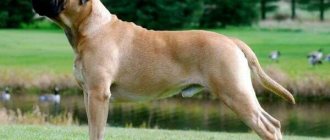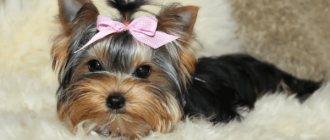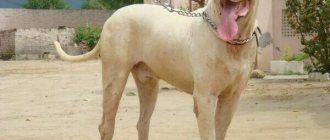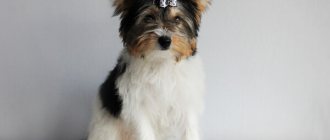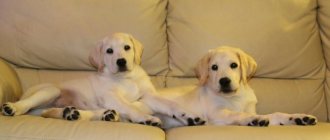Russian toy terrier - This is the smallest representative of the terrier family in the world, and perhaps among other breeds of small dogs. It is no coincidence that this breed is listed in the Guinness Book of Records as the dog with the smallest weight - only 681 grams.
Outwardly, the Russian Toy is similar to both the Chihuahua and the Prague Rat, but at the same time there are differences. We will talk about them in more detail in another article. This little, tiny dog, thanks to its character, is a great friend and companion dog . She is perfect even for an inexperienced, novice dog breeder, and will also be a favorite of all family members, without exception. “This is a cheerful, playful, very active dog, ready to accompany you anywhere and everywhere. It is quite suitable for older people who cannot cope with large breed dogs. In addition, it is easy to maintain and will be an excellent companion for daily walks in the fresh air.
Origin story
This breed appeared in England in the 18th century . Initially, it was popular precisely as an urban one. The dog was needed for fox hunting, as well as for participating in rat fights, which were popular at that time.
The ancestors of Toy Terriers are considered to be the English Black and Tan Terrier and the Manchester Terrier..
Despite the popularity of the breed specifically in the fight against rats, the miniature dog very quickly charmed the high society. For a long time, these dogs were very fashionable in their homeland.
The first toy terrier exhibitions began in 1920 . At that time, this breed was divided into two types according to weight category. The black and tan type of terrier belonged to one of them. The breed received the official name English Toy Terrier only in 1962.
In Russia they were breeding Russian toy terriers when they were almost on the verge of extinction. This breed gradually divided into smooth-haired dogs and Moscow long-haired dogs.
Description of the breed
The Toy Terrier is primarily a lap and decorative dog..
She is a companion breed. The dog has thin, long legs and a lean build. By nature, these dogs are very cheerful and energetic.
NOTE!
They have a cheerful character, and it can differ between males and females. Aggression and cowardice are not characteristic of toys.
Dogs have a wedge-shaped skull, a scissor bite, lips that are dry and tight-fitting, and should be black. The animal has large ears, shaped like an isosceles triangle.
They should stand and the ears should be open.
The breed has dark eyes, slightly protruding and wide-set . Strabismus is excluded.
Dogs' tails are docked, leaving only 2-3 vertebrae.
The dog moves easily, freely and quickly . There should be no folds on the skin. It fits tightly to the body.
Mating
Toys are easier to breed than large dogs. They don’t need a long introduction, a long walk, or a lot of free space. But to untie the dogs, it is still recommended to invite a trained person who will tell you how to properly help the animals.
Puberty comes to these dogs early: at 8-10 months, the bitch begins her first heat, and males mount soft toys or furniture. This habit needs to be weaned off gently, but you should not scold your pet so as not to disturb its psyche. Otherwise, adult Toy simply will not want to mount a girl.
Toy terriers can be untied at 20-25 months, when their bodies are able to conceive and bear offspring. At this time, the girl should go into her third heat. The most favorable time is 13-15 days from the beginning, when light discharge appears, the loop loosens, and the bitch’s behavior changes to playful.
If the dogs are breeding dogs and have status, then they need to be bred through a kennel. Owners must fill out certain forms and obtain a certificate. The male is selected in advance, the owners set a date and determine the price. It is usually equal to one puppy or a percentage of its value, depending on the number of heads in the litter. If the bitch is empty, mating is not paid.
The girl is brought into the territory of the male dog, where he will feel relaxed. When the boy makes the cage, the animals need to be helped: hold them so that they do not lose their balance, guide the male into the loop. Sexual intercourse lasts 10-15 minutes . Even in the absence of a castle, the female can be plump. Mating is repeated after 2 days .
Read a detailed article on the topic: “Everything you need to know about breeding dogs: appropriate age, what to do if it doesn’t work out, rules and tips.”
Pet character
These are very kind and sympathetic dogs. They are loyal to their owner and love all family members.
Also, Russian Smooth-haired Toy Terriers are very confident and proud. Dogs do not allow themselves to be treated poorly and can be offended for a long time.
Dogs have well-developed hearing and sense of smell . A loud bark can always alert you if intruders are trying to get into the house. Despite its small size, the dog will always defend its owner if he is in danger.
Animals of this breed are easy to train, although they can show some cunning. You cannot indulge their whims, but learn to recognize their tricks and prevent them.
Neither by temperament nor by physique, toy terriers are suitable for children . Children can accidentally damage a fragile animal, which can cause it to become aggressive and bite.
Dogs do not tolerate loneliness well, but get along very well with other pets.
They have a very serious character and sometimes difficult temperament, which is why you need to find a special approach to them.
Nicknames of toy terriers
A cute and funny pet usually gets a corresponding cute nickname. You can name a boy a toy terrier taking into account one of the following factors:
- small size dogs: Funtik, Malysh, Krosh;
- cheerful character of the pet: Shumok, Volcano, Energizer.
Nicknames for girls are selected according to the same principle, but in such a way that they emphasize the elegance and grace of a small dog: Barbie, Bead, Doll, Lady, Princess, Jasmine.
Sometimes the owners approach this issue with humor, then tiny Tyson, Thunder, Giant or Yula, Tyapa, Knopochka rush around the apartment.
Breed standard photo
- General form. A thin-legged, elegant dog with a weakly defined sexual type. Looks proportional and harmonious;
- Important proportions: the length of the body is equal to the height at the withers, the height at the elbow is slightly more than half the height at the withers, the chest reaches the level of the elbows, the muzzle is shorter than the skull;
- Behavior and temperament. Always an active and cheerful dog. Not distinguished by malice or cowardice, devoted to the owner;
- Head. Smaller than the body. It has a wedge shape. The nose and lips are black. Scissor bite, teeth white and medium in size. The ears are large and erect. They have the shape of a triangle;
- Neck. Long and tall.
- Frame. The withers are slightly pronounced, the back of the dogs is strong and straight. The croup is slightly sloping, of medium width, the lower abdomen is tucked;
- Tail. In Toys it is of medium length, saber- or sickle-shaped. There should be no creases or thickenings. When moving, it should not fall below the level of your back, but also not lie on it. Cupping is allowed;
- Limbs. When viewed from the front, they are parallel. The paws are small, the pads are soft, the toes are gathered into a ball. Claws and pads dark;
- Movement. Free and energetic, should be moderately sweeping. When moving, the head is held proudly, the tail is located high;
- Dimensions and weight. On average, the height of a toy terrier is 22-27 cm, and its weight is up to 3 kg.
Any deviation from the standard is a defect . It is up to you to decide whether to purchase a dog that is disqualified at a show.
Expert opinion
Kozhevin Semyon Kirillovich
Expert dog handler.
“Compared to other small breeds, toys are not as aggressive. Even if they treat strangers with disdain, they will not attack them if they came with their owner. A lot of things also concern care. They hardly shed and do not smell. They need to be bathed very rarely. I think a lot of owners find it beneficial.”
Dossier
Adult height: 20-28 cm. Weight: from 1.5 kg to 3 kg. Characteristic color: can be red, black, brown, blue, lilac. The color is plain or with tan marks. Coat length: short. Life expectancy: from 15 to 18 years. Advantages of the breed: cheerfulness, activity, love for the owner and family, sociability. Difficulties of the breed: easily excitable psyche. Average price: $200-700. Classification: small breed, decorative, companion dog.
Basic colors
Acceptable colors are black and tan, brown and tan, blue and tan, lilac and tan, red and black, red and blue, red, fawn, red and brown, red and lilac, cream, chocolate.
The following are considered unacceptable coat colors: brindle, piebald, spotted, white , marbled .
Advantages and disadvantages
Advantages:
- Attractive appearance and small size;
- Can be kept even in a small apartment;
- They do not require a lot of feed and products;
- Gets along well with children and other animals if raised properly;
- It's easy to move around with this dog;
- Care is straightforward and simple;
- Sometimes you can neglect a walk - the dog can use the tray.
Flaws:
- Frail health and brittle bones;
- Difficulty in diagnosing diseases;
- Expensive and difficult treatment;
- Without training, a dog can become aggressive and angry.
Life expectancy, illness and health
Like all decorative dogs, toy terriers have a high life expectancy. It is 12-15 years old.
Most diseases of this breed occur due to improper care . So the dog's health depends only on you.
With proper attention and care for your pet, he will live a long time and have an excellent and strong body.
Factors influencing longevity:
- Proper nutrition;
- Vaccinations;
- Correct handling.
The most common diseases of toy terriers:
- Problems with the musculoskeletal system;
- Neurological diseases;
- Diseases of internal organs.
But it is also important to pay attention not only to these aspects, because the breed is prone to epilepsy, allergies and baldness of various areas on the body.
Types of crossbreeds
Mixed breeds are dogs born as a result of mating representatives of two different breeds.
Toy Terriers are most often crossed with:
- Yorkshire terriers;
- dachshunds;
- Maltese dogs;
- Pekingese;
- chihuahua;
- Spitz;
- Jack Russell Terriers;
- miniature pinschers.
Also read about the comparison between the Pinscher and the Toy Terrier.
Toy terrier mixes
are not officially recognized by any canine association .
Basic rules of care
Shorthaired Toys do not need to be cut, just brushed at least once a week.
There is no need to bathe often; the frequency should be once every 10 days .
Since the Toy Terrier has large eyes, they require close care. Wipe them down from time to time.
Large ears need regular examination.
A lot of sulfur should not accumulate in them, and there should not be an unpleasant odor coming from there. Once a month they need to be wiped, cleaned more often, but only the outer side of the auricle.
After a walk, you should wipe your paws with a damp cloth. This is especially true in winter, when roads are sprinkled with reagent. Make sure your pet does not lick them, otherwise he may get poisoned.
Nails should be trimmed once a month and the sharp ends should be smoothed with a nail file .
You should also treat your pet for fleas, ticks and parasites every month.
Once a week, examine and brush your dog’s teeth with a special device.
How to feed
It doesn’t matter which option you choose - dry food or natural - the main thing is that the nutrition is balanced and correct.
If you decide to buy food in specialized places, then choose premium or super-premium class.
Only such food can provide a dog with the entire range of vitamins it needs.
If you decide to feed your dog natural food, the diet should include::
- Porridge (rice, buckwheat);
- Meat (veal, chicken);
- Sea fish;
- Seasonal vegetables and fruits;
- Fermented milk products (low-fat cottage cheese, kefir).
There should be enough food so that the dog is full and not overeating. It is easy to overfeed such a small breed, which will lead to obesity.
Do not forget about strictly prohibited foods for this breed:
- Smoked meats;
- Sweets;
- Spicy, fatty, fried foods;
- Grape.
Don’t forget to remove spoiled food from the bowl and change the water on time.
What puppies look like
Toy terrier puppies in infancy bear little resemblance to their parents .
They are very tiny, blind, their ears and tail are pressed to the body. The claws on the paws are not yet completely strong, and there are no teeth.
As the puppy grows up, it becomes more like its parents . His ears stand up, his tail begins to wag, his muzzle stretches out.
In toy terriers, from birth you can understand what color the dog will have in the future.
Color variations
There are several coat color options for Toy Terriers.:
- black and tan - the black color should not have any shades, the tan is on the face, ears, chest and near the temples;
- sable - toi with red hairs at the roots and black at the ends;
- chocolate, brown and red - most often found in Russian Toy Terriers, these colors are difficult to preserve in offspring;
- blue and purple - arise as a result of the activity of a recessive gene;
- fawn - acceptable options are from light red to milky white;
- isabella - a color derived from lilac, rare;
- white - such dogs are attractive in appearance, but cannot participate in exhibitions and breeding.
The variety of colors is explained by the fact that 2 pigments and 10 genes are involved in their formation.
How to choose?
- Evaluate the dog’s exterior: the puppy should look like a small deer – long legs and a high chest;
- The body, when viewed from the side, should look like a square. The height of the puppy is equal to the length of its body;
- If you are going to take a puppy for exhibitions, there should not be any white spots on it. If not, a small white spot on the chest or paw is acceptable;
- The eyes should be prominent, not bulging;
- Look at the mouth and bite;
- The back should be level, the tail without kinks or thickening, the withers higher than the croup.
- Don't forget to evaluate the temperament: the dog should not be aggressive, timid or cowardly. The dog must be able to eat well on its own, communicate correctly with its fellow dogs and be moderately curious;
- Do not take a lethargic or inactive pet. Pay attention to the conditions in which the puppy is kept, the nature of the parents;
- Also, it should not give off an unpleasant odor, in particular from the mouth and ears;
- The skin should be free of fleas, ticks and bald spots.
What not to do with a dog
It is worth remembering about safety measures for your pet. This dog should not be placed in bed with you, or placed on a chair or armchair, to avoid injury.
Toys for animals should be made of hard rubber. Rags should not be given to the puppy, due to the risk of swallowing some of them. If you see that your baby is playing with something soft, take it away, but do not pull (this can break the animal’s bite), but slightly unclench the jaws.
You need to pick up the puppy correctly - your left hand under the chest, your right hand holding it. It looks like a puppy is sitting on your right hand. Holding a puppy differently is not recommended. And when you go somewhere in the evening, leave your pet a light and plenty of toys so that he doesn’t worry. You can throw a few bones for the teeth of the baby. Then he will know exactly what to do with himself.

